Research Spotlights showcase innovative projects from the natural hazards engineering community that have leveraged SimCenter tools to advance their work. These highlight how researchers are applying SimCenter’s open-source software to address real-world challenges—improving hazard resilience, enhancing infrastructure performance, and fostering sustainable, community-focused solutions.
Highlight your research -- If you have employed SimCenter tools in your research and would like to share your outcomes, we invite you to contact us at nheri-simcenter@berkeley.edu for consideration. By sharing your research through our Research Spotlights, you will have the opportunity to:
SimCenter software: R2D
Keywords: hurricane, Louisiana, wind, Hurricane Laura, regional loss assessment
This study presents an augmented parcel approach leveraging various sources of open data, machine learning modules, and time-evolving rulesets to support Hazus-compatible risk assessments on a wide class of buildings under hurricane wind and flood hazards. These techniques are implemented within the open-source regional hurricane loss assessment workflow of the Natural Hazards Engineering Research Infrastructure (NHERI) SimCenter. Illustrative examples demonstrate building inventory generation in both data-rich and data-scarce environments. Validations further reveal the challenges of simplifying complex contemporary roof geometries to the simplified shapes adopted in Hazus and the criticality of accurate year built data, given the augmented parcel approach’s reliance on time-evolving code-based rulesets. Published field observations collected in Lake Charles, Louisiana, following the landfall of Hurricane Laura, demonstrate that the use of an augmented parcel inventory within the SimCenter’s workflow for Hazus-compatible loss assessments yields damage states consistent with ground-truth observations for minor to moderate damage states.
The study was conducted within the NHERI SimCenter using its open-source regional hurricane loss assessment workflow, with developers directly contributing to the modeling, analysis, and validation. SimCenter resources enabled integration of augmented parcel inventories, machine learning-derived attributes, and Hazus-based fragilities into a streamlined end-to-end workflow. All curated building inventories and supporting tools were published on DesignSafe for community use, offering reproducible methods for addressing gaps in open data. Societal impacts include providing policymakers, engineers, and emergency planners with reliable methods for generating accurate regional inventory data where it is scarce, highlighting the limitations of existing federal datasets, and informing strategies to improve hurricane damage prediction and resilience planning for vulnerable communities.
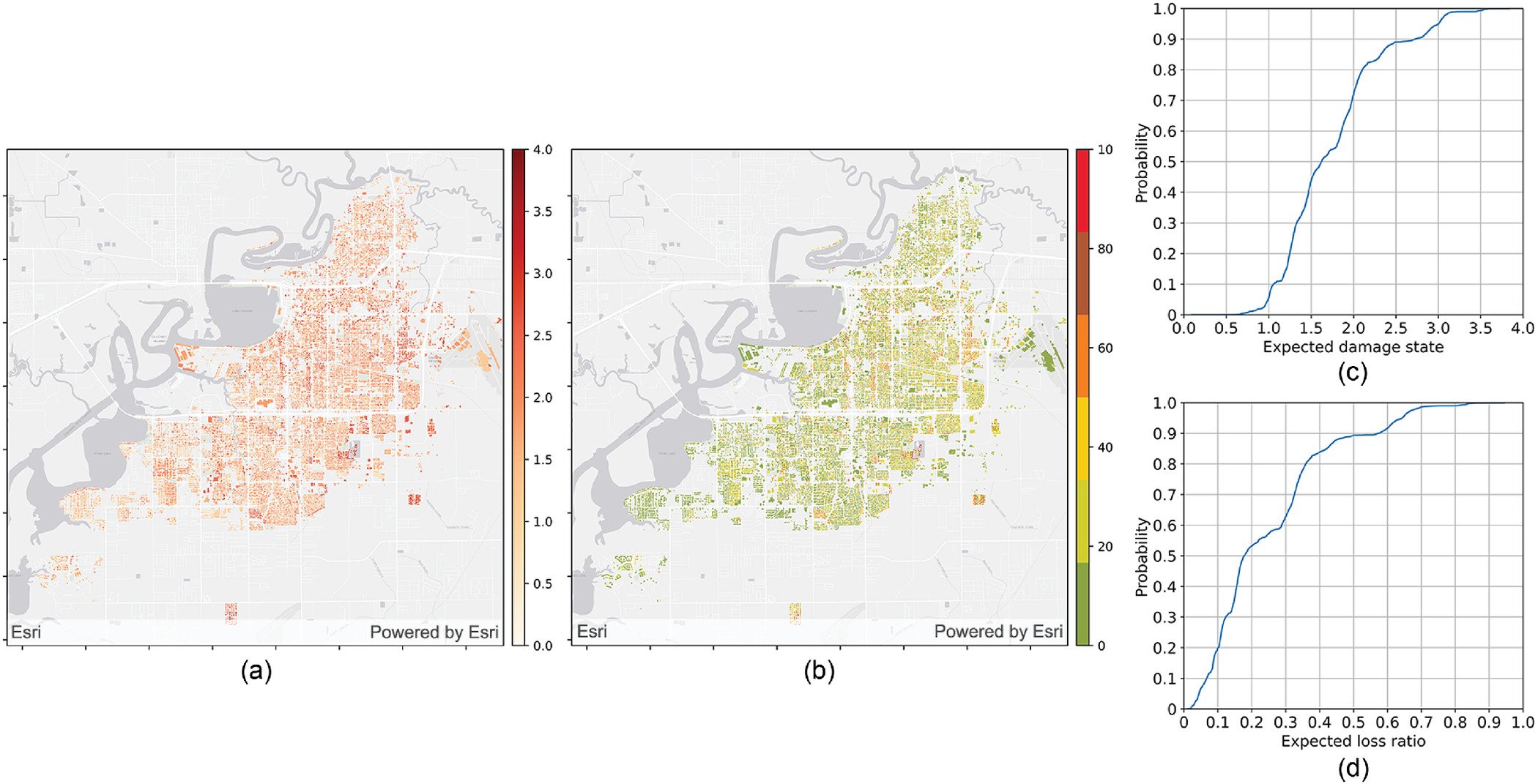 |
Publication:
Kijewski-Correa, Tracy, Barbaros Cetiner, Kuanshi Zhong, Chaofeng Wang, Adam Zsarnoczay, Yunhui Guo, Meredith Lochhead, and Frank McKenna (2023). “Validation of an augmented parcel approach for hurricane regional loss assessments,” Natural Hazards Review, 24(3), https://doi.org/10.1061/NHREFO.NHENG-1649
See also,
a. Documentation for Lake Charles are available in DesignSafe (https://doi.org/10.17603/ds2-83ca-r890).
b. The pair of inventories and rulesets for Atlantic County are also available in DesignSafe (https://doi.org/10.17603/ds2-jpj2-zx14)
c. See https://doi.org/10.5281/zenodo.5033626 for R2D application used
Project webpage: https://simcenter.designsafe-ci.org/products/testbeds/
Source code: https://nheri-simcenter.github.io/R2D-Documentation/index.html
Funding: NHERI-SimCenter Awards CMMI 1612843 & 2131111
SimCenter software used: EE-UQ and pelicun
Keywords: recovery-based design, FEMA P-58, optimization, surrogate modeling, functional recovery
This research presents a machine learning–based optimization framework to support recovery-based design, addressing the challenge of linking building-level engineering decisions to broader community resilience goals. Traditional downtime simulations are computationally intensive, making it difficult to evaluate above-code design strategies across the full range of possible interventions. The framework integrates FEMA P-58 loss assessment, ATC-138 functional recovery modeling, and surrogate modeling to efficiently explore thousands of design alternatives against explicit recovery targets. In a three-story office building case study in Oakland, CA, the study found that targeted nonstructural upgrades—such as improvements to stairs, curtain walls, and HVAC units—were essential to achieve ambitious recovery goals. By contrast, structural-only upgrades sometimes increased recovery times by amplifying acceleration demands, highlighting the complex trade-offs inherent in recovery-based design.
NHERI SimCenter tools played a central role in enabling this research. EE-UQ was used to run nonlinear response history analyses, while pelicun powered the large-scale FEMA P-58 loss assessments necessary to train surrogate models at scale. Together, these tools made it feasible to generate the consistent, high-volume datasets required for optimization. The research team released their workflow and open-source code, providing a reproducible platform that other researchers, engineers, and policymakers can adopt to explore recovery-based design strategies. In the long term, this approach has the potential to inform evolving functional-recovery provisions, guide benefit–cost analyses, and support community resilience planning by offering practical, quantitative tools to balance structural and nonstructural interventions for post-earthquake recovery.
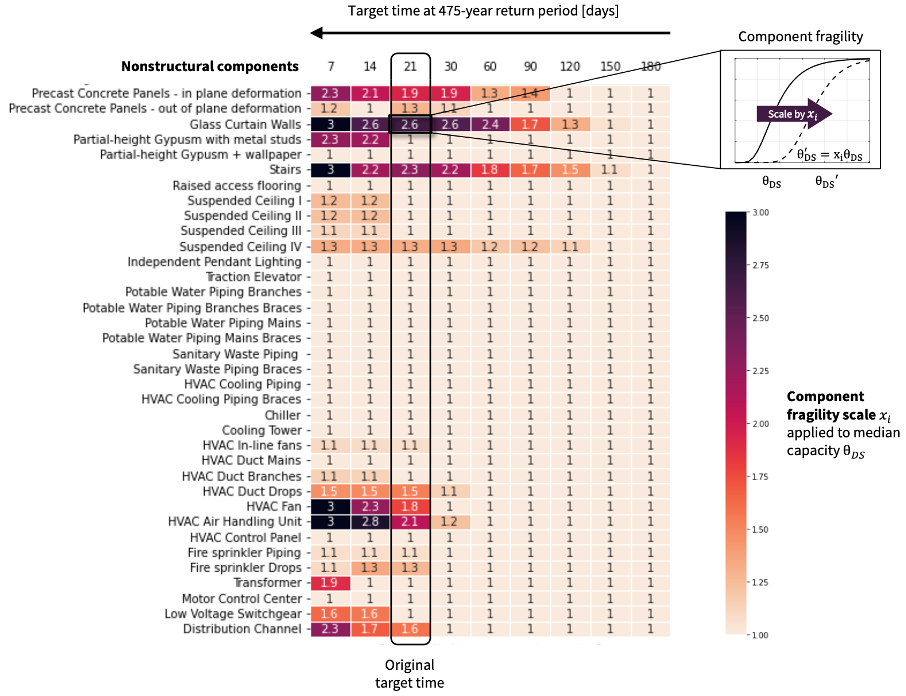
Publications:
Issa, O., Silva-Lopez, R., Baker, J.W., Burton, H.V. (2023). Machine-learning-based optimization framework to support recovery-based design. Earthquake Eng. Struct. Dyn. https://doi.org/10.1002/eqe.3860
GitHub page to source code: https://github.com/0marissa/RBD-optimization
Funding: This work was supported by the National Science Foundation (NSF) under Award No. CMMI-2053014 and the Stanford Shah Family Fellowship.
SimCenter software used: R2D
Keywords: hurricane, Florida, wind, open data, regional loss assessment
This study presents an extension of the R2D tool to conduct parcel-level and component-level hurricane performance assessments outside of the SimCenter's testbed locations. The study first details how building inventories that capture time-evolving building characteristics and regional construction practices can be generated using updated heuristic rulesets that guide the integration of tax assessor data with other open data sources. These rulesets and supporting data are then utilized to generate building inventory information for a set of single-family homes located in Florida's Bay County, the landfall site of Hurricane Michael in 2018. HAZUS-compatible, parcel-level damage and loss assessments are then conducted, considering Hurricane Michael's peak gust wind speeds. Finally, a set of custom fragilities, empirically-derived from multiple regional post-disaster datasets, are incorporated into R2D to conduct the first component-level damage assessment of buildings under hurricanes using the SimCenter's regional loss modeling workflows.
The R2D tool served as the central platform for managing the workflow—from hazard footprint ingestion to probabilistic loss estimation—leveraging its ability to integrate multiple datasets, fragility curves, and advanced modeling approaches. The project’s outputs, including calibrated regional fragility models and complete replication datasets, were shared openly via DesignSafe, expanding resources for the hazard engineering community. Findings from the analysis demonstrated the measurable benefits of Florida’s strengthened building codes in reducing losses, and these insights were presented to the Senate Climate Solutions Caucus and the Florida Chief Resilience Officer. By combining open data, advanced modeling, and policy-relevant insights, this research enhances hurricane risk assessment capabilities and informs resilience strategies for communities across hurricane-prone regions.
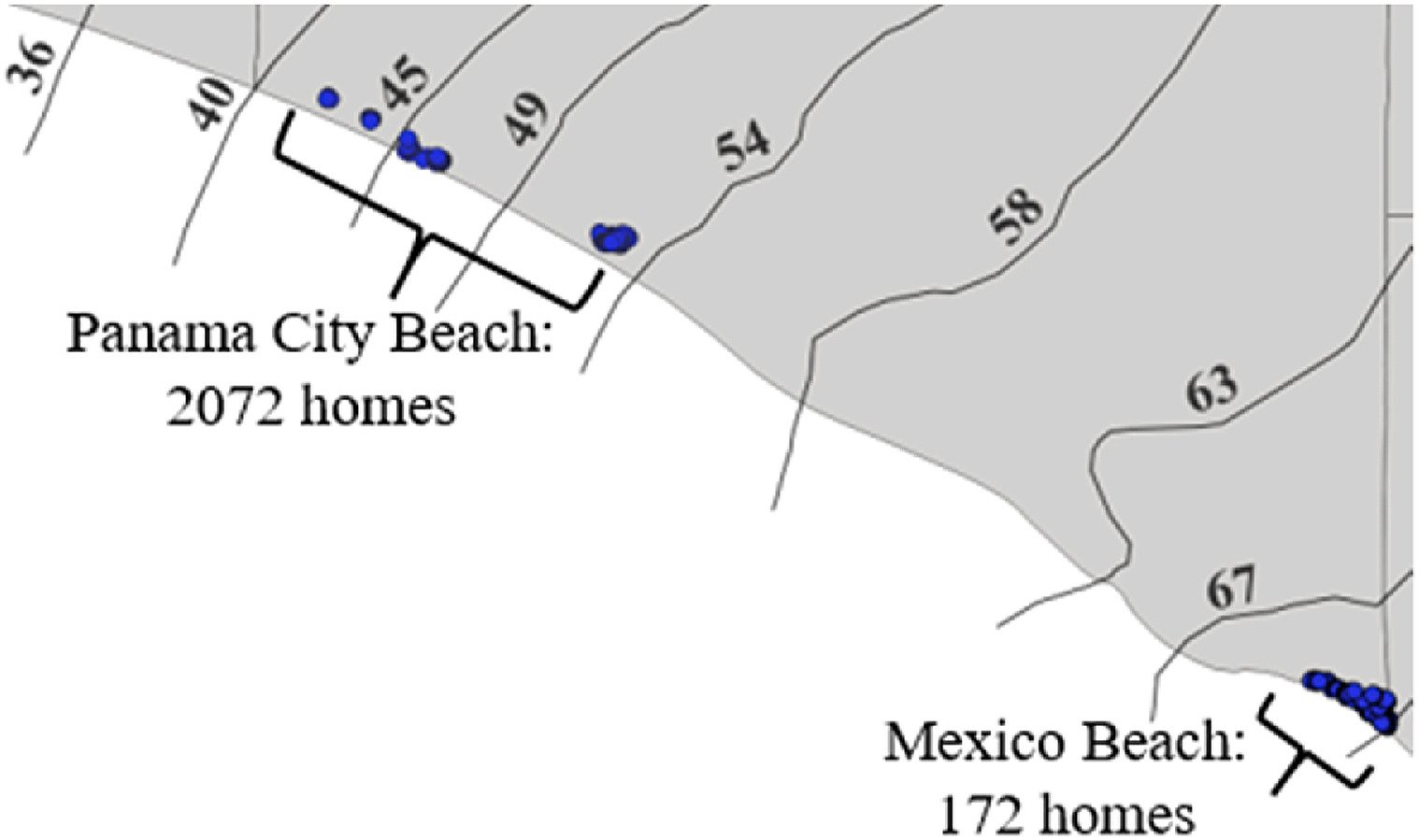
Publication:
Angeles, K., & Kijewski-Correa, T. (2023). Advancing parcel-level hurricane regional loss assessments using open data and the regional resilience determination tool. International Journal of Disaster Risk Reduction, 95, 103818. https://doi.org/10.1016/j.ijdrr.2023.103818
Source code: We contributed back to SimCenter code repository and additional rulesets were published at https://doi.org/10.17603/ds2-3fvv-8430
Funding: NSF Graduate Research Fellowship (DGE-1313583), NHERI-SimCenter Awards CMMI 1612843 & 2131111
SimCenter software used: BRAILS (now updated to BRAILS++)
Keywords: Building Data, Machine Learning, Data Augmentation Process, Mass Deep Energy Retrofits (DERs)
The Building Identification Tool (BIT) was developed to streamline the process of identifying buildings suitable for prefabricated panelized deep energy retrofits (PPDERs)—a strategy capable of reducing energy demand in existing buildings by 50–80%. A key barrier to scaling such retrofits is the scarcity of accessible, high-quality building envelope data, which is traditionally obtained through costly on-site inspections. BIT addresses this challenge by providing a web-based platform that enables users—such as portfolio managers, retrofit accelerators, and housing agencies—to upload building datasets, retrieve associated imagery from Google Street View and satellite sources, and design custom surveys to crowdsource missing building information. With integrated preprocessing capabilities, BIT transforms inconsistent and incomplete registry data into structured, geo-referenced databases. In partnership with social housing authorities in Quebec, the tool has been used to remotely characterize more than 3,000 buildings, providing critical data to guide retrofit prioritization, align projects with emissions-reduction targets, and improve occupant well-being.
The research also integrated machine learning into the retrofit selection workflow by leveraging the NHERI SimCenter’s BRAILS (now updated to BRAILS++) platform. SimCenter’s pre-trained NFloorDetector model and training datasets were used to test the feasibility of automatically identifying building attributes—such as floor count—from street and satellite imagery. These experiments demonstrated both the potential and the current limitations of model-assisted surveying, shaping a roadmap for progressively replacing manual inputs with automated computer vision techniques. By closing critical data gaps, BIT offers public sector agencies a scalable approach to develop retrofit pipelines, improve resource allocation, and advance climate action goals. Beyond reducing greenhouse gas emissions, the tool supports community resilience by identifying clusters of vulnerable buildings for targeted upgrades and by enabling life cycle and emissions-reduction analyses that inform sustainable retrofit strategies.
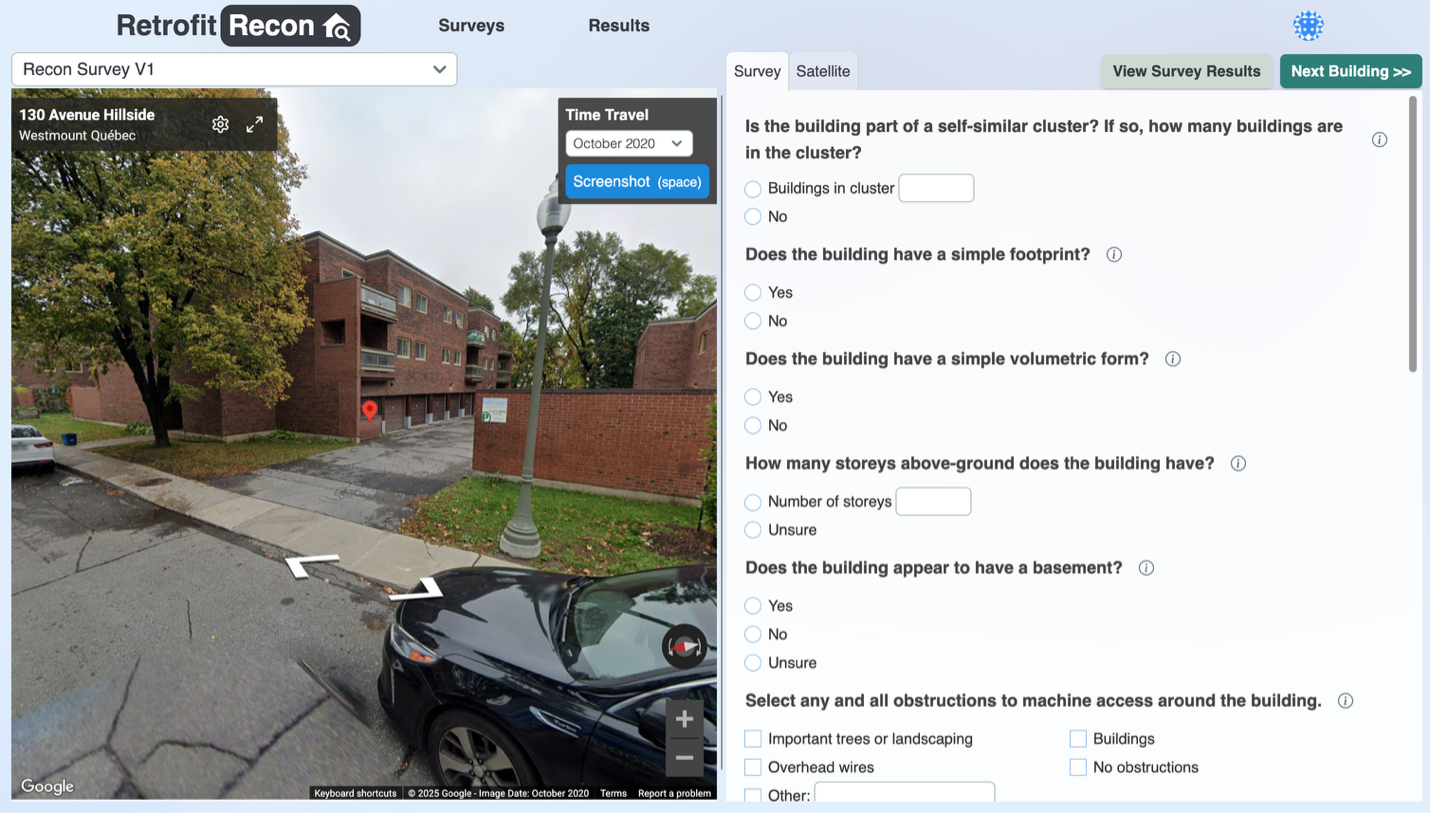
Publications:
BIT Publication at the 112th ACSA Annual Meeting: https://www.acsa-arch.org/chapter/developing-a-building-identification-tool-to-support-mass-deep-energy-retrofits/
Learn more about the Architecture, Energy and Environment lab: https://aeechair.research.mcgill.ca/en/initiatives
SimCenter software used: Method implemented into quoFEM
Keywords: Hierarchical Bayesian inference, Steel material models, Uncertainty quantification, Constitutive model calibration, Aleatory variability
This research introduces a hierarchical Bayesian framework for calibrating numerical models that is broadly applicable across disciplines. The framework provides a systematic way to capture both epistemic uncertainty and aleatory variability by leveraging experimental data from multiple specimens or datasets. Unlike traditional Bayesian approaches that either pool all data or analyze each sample independently, the hierarchical method quantifies population-level statistics while also representing specimen-to-specimen variability. To demonstrate its capability, the framework was applied to calibrate the Giuffré–Menegotto–Pinto steel constitutive model using cyclic stress–strain data from thirty-six Grade 60 reinforcing steel coupons. The results show improved predictive accuracy for new specimens and establish probabilistic parameter models that can be used for forward uncertainty propagation in nonlinear structural analysis, reliability studies, and risk assessments.
The project incorporated NHERI SimCenter’s quoFEM tool to implement and share hierarchical Bayesian calibration workflows with the research community. By providing a documented example, open-source Python implementation, and a subsampled dataset, the study ensures accessibility and reproducibility while supporting engineering education on uncertainty quantification. While demonstrated on reinforcing steel, the framework is agnostic to the specific model being calibrated and can be extended to a wide range of engineering and scientific applications. It has long-term potential to improve structural reliability and resilience assessments, and advance simulation-based approaches for safer, more hazard-resistant infrastructure.
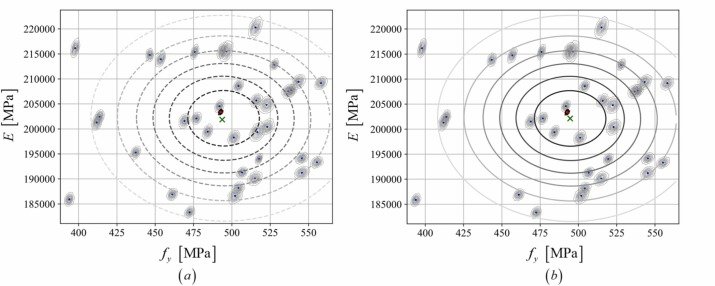
Fig. 19. Contours of the KDE of the marginal joint posterior distribution (epistemic uncertainty) of the and parameters for each of the coupons (in grey) with its sample mean (in blue) for the: (a) non-Hierarchical case; and (b) Hierarchical case. In both plots: (1) the contours and sample mean from the pooled case (with all 36 coupons, see Fig. 11) are shown in black and red, respectively, (2) the center of gravity (sample mean) of all the coupon-by-coupon sample means (in blue) is marked with a green cross, and (3) the large elliptical contours are those of the parent distribution (aleatoric uncertainty) defined by the posterior sample means of the hyperparameters and . (https://doi.org/10.1016/j.engstruct.2024.118409)
Publication:
Kurumbhati, M.M., Ramancha, M.K., Satish, A.B., Conte, J.P., Lotfizadeh, K.H. (2024). Hierarchical Bayesian modeling for calibration and uncertainty quantification of constitutive material models: Application to a uniaxial steel material model. Engineering Structures, 318, 118409. https://doi.org/10.1016/j.engstruct.2024.118409
Funding:
(1) the Eric and Johanna Reissner Chair in the Department of Structural Engineering at UC San Diego, (2) the NSF NHERI SimCenter at UC Berkeley under award no. CMMI- 2131111., and (3) USACE Engineer Research and Development Center (ERDC) Cooperative Agreement W9132T-22–2-0014.
SimCenter software used: R2D
Keywords: resilience, recovery modelling, earthquake, resource constraints
This research introduces a novel approach for simulating regional post-disaster recovery, addressing a key gap in community resilience assessment. Using the iRe-CoDeS framework, recovery is modeled as a time-stepping process where the interplay between demand and supply for critical resources and services determines how quickly community components can return to operation. The framework incorporates resource constraints and other impeding factors to quantify their effects on recovery timelines through a multi-dimensional “Lack of Resilience” (LoR) metric. Applied to housing in northeast San Francisco following a simulated Mw7.2 earthquake on the San Andreas Fault, the study shows that the recovery model produces results consistent with existing housing resilience estimates while also providing new insights into when and how unmet resource demands slow community recovery.
The NHERI SimCenter’s R2D tool – and its backend workflow, rWhale – were integral in generating building damage estimates for the San Francisco case study, which served as input to the iRe-CoDeS recovery model. The work produced open-source software that extends the R2D Tool’s capabilities to simulate community-level recovery, enabling researchers and practitioners to explore the impacts of resource constraints on urban resilience. By providing a consistent framework for modeling component interdependencies during both operation and repair, this research lays the groundwork for improved disaster recovery planning. In the future, these capabilities could help local governments identify resource bottlenecks, prioritize investments, and accelerate community recovery after major earthquakes.
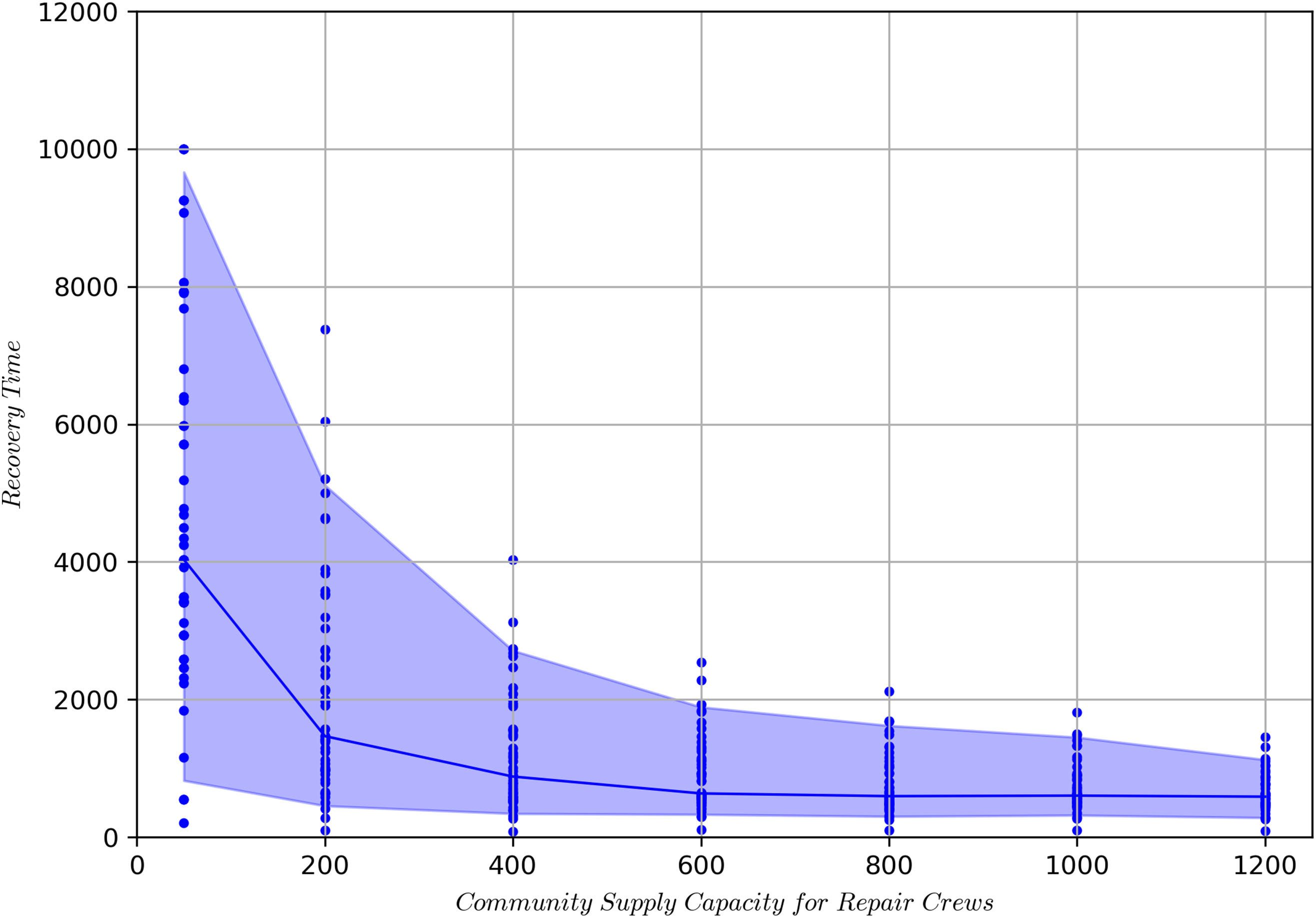
Publication:
Blagojevic, N., Stojadinovic, B. (2022) A demand-supply framework for evaluating the effect of resource and service constraints on community disaster resilience. Resilient Cities and Structures. 1(1) 13-32. https://doi.org/10.1016/j.rcns.2022.03.001
Resources:
pyrecodes website
GitHub source code
Funding: ETH Zurich
SimCenter software used: quoFEM
Keywords: Liquefaction, Bayesian calibration, Uncertainty propagation, Sensitivity analysis, quoFEM
This project advances geotechnical earthquake engineering by developing a probabilistic framework for calibrating and predicting soil liquefaction. Through sensitivity analysis, Bayesian calibration with cyclic direct simple shear test data, and forward uncertainty propagation, the study produced robust predictions of liquefaction-induced lateral spreading while explicitly accounting for parameter uncertainty and multimodality. The outcomes include probabilistic parameter distribution models for PM4Sand, validation against experimental cyclic strength curves, and the release of open-source workflows and data. By sharing reproducible Jupyter Notebooks, DesignSafe datasets, and calibrated models with the broader community, the project enhances confidence in liquefaction simulations and provides researchers and engineers with practical tools for uncertainty-informed, performance-based design.
The NHERI SimCenter’s quoFEM application enabled this work through its streamlined workflow for end-to-end probabilistic analysis by integrating sensitivity studies, Bayesian calibration, and forward uncertainty propagation. NHERI resources not only accelerated the research but also ensured that the results are directly accessible to the community as a DesignSafe UseCase. The research offers societal value by improving hazard communication with clear, probabilistic predictions of liquefaction risk. The probabilistic treatment of soil parameters and liquefaction-induced deformations provides evidence that can guide updates to seismic design codes and standards for geotechnical systems.

Publications:
Satish, A.B., Yi, Sr., Nair, A.S., Arduino, P. (2022). Probabilistic Calibration and Prediction of Seismic Soil Liquefaction Using quoFEM. In: Wang, L., Zhang, JM., Wang, R. (eds) Proceedings of the 4th International Conference on Performance Based Design in Earthquake Geotechnical Engineering (Beijing 2022). PBD-IV 2022. Geotechnical, Geological and Earthquake Engineering, vol 52. Springer, Cham. https://doi.org/10.1007/978-3-031-11898-2_152
Yi, Sr., Satish, A.B., Nair, A.S., Arduino, P., Zsarnóczay, A., McKenna, F. (2023). Sensitivity Analysis and Bayesian Calibration of OpenSees Models Using quoFEM. In: Di Trapani, F., Demartino, C., Marano, G.C., Monti, G. (eds) Proceedings of the 2022 Eurasian OpenSees Days. EOS 2022. Lecture Notes in Civil Engineering, vol 326. Springer, Cham. https://doi.org/10.1007/978-3-031-30125-4_6
Funding: NSF NHERI SimCenter under award no. 1612843 & 2131111
SimCenter software used: BRAILS (now updated to BRAILS++)
Keywords: Virtual Testbed, Community Resilience, Computer Simulation, Building Inventory, Population Inventory
Researchers developed a standardized workflow for creating virtual community resilience testbeds—digital platforms that integrate hazard, infrastructure, and population data to assess disaster impacts, disruptions, and recovery processes at the community scale. This framework defines minimum requirements for hazard and community modules, outlines methods for data collection and integration, and specifies steps for verification, validation, visualization, and publication. Demonstrated through the Onslow County, NC Testbed, the approach incorporates hurricane and flood hazard models alongside detailed building, infrastructure, and population inventories. All datasets, algorithms, and metadata are openly published on DesignSafe-CI, enabling other researchers, educators, and policymakers to replicate, adapt, and expand these resources for resilience analysis and planning.
The project leveraged SimCenter’s BRAILS (now updated to BRAILS++) to automatically extract missing building attributes from aerial imagery—filling key data gaps in the inventory—and used DesignSafe-CI for hosting and preserving the complete testbed package. The resulting architecture supports modular, reusable components, promoting equitable access to advanced modeling capabilities. Beyond research contributions, the framework has been incorporated into resilience and hazard modeling courses, fostering workforce development, and holds potential to improve community-specific resilience planning. By lowering barriers to complex resilience simulations, this work accelerates convergence research and strengthens decision-making for hazard mitigation and recovery.
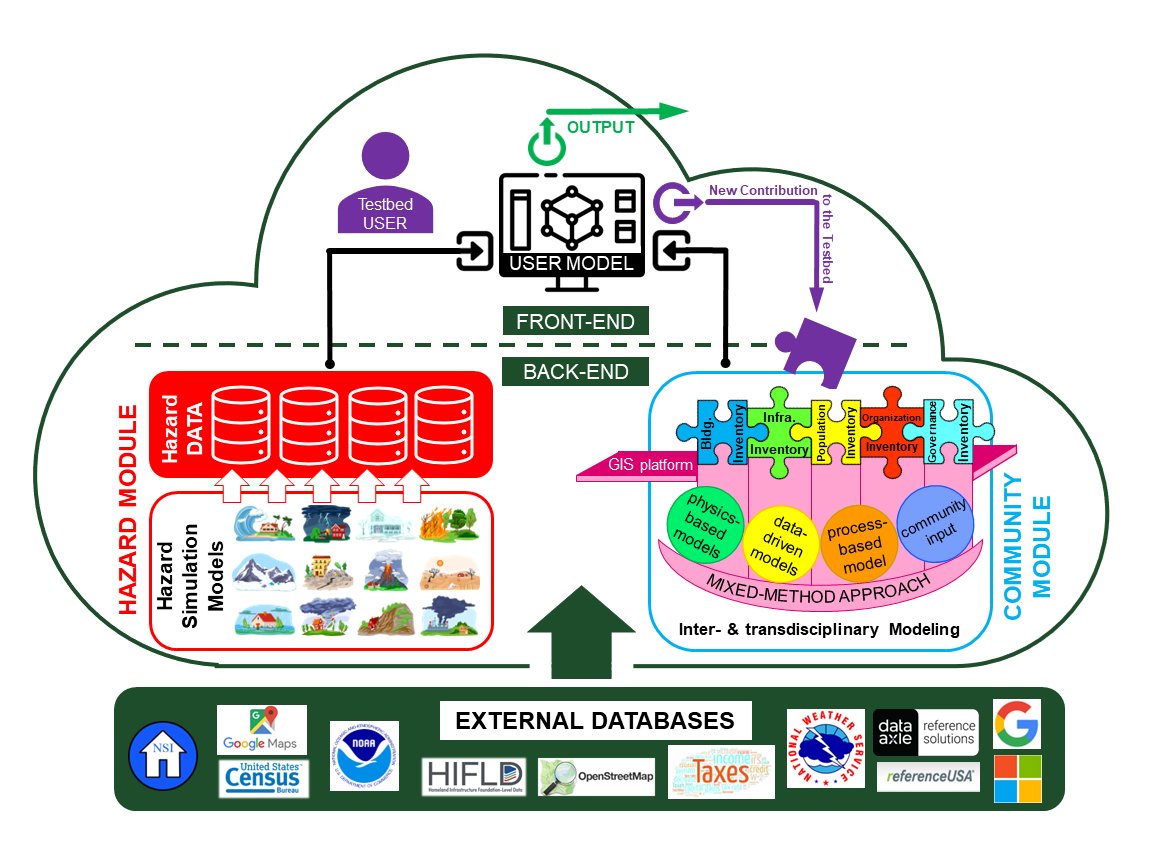
Publication:
Enderami, S. A., Sutley, E. J., Mazumder, R. K., & Dumler, M. (2023). Virtual Testbeds for Community Resilience Analysis: Step-by-Step Development Procedure and Future Orientation. Resilient Cities and Structures, 2(2), 42-56. https://doi.org/https://doi.org/10.1016/j.rcns.2023.07.002
Funding sources:
National Science Foundation/Grant No. CMMI 1847373
Center for Risk-Based Community Resilience Planning (70NANB20H008)
SimCenter software used: R2D, NJ Testbed
Keywords: Disaster displacement, disaster risk, displacement duration, household displacement, machine learning
This research advances the understanding of disaster-driven household displacement by developing predictive models that estimate both the likelihood and duration of displacement following natural hazards. Using data from the U.S. Household Pulse Survey, the study introduces three models—ranging in complexity and predictive power—to determine whether a displaced household will return within a month, return after a month, or not return at all. The analysis also examines the relative influence of physical and socioeconomic factors on displacement outcomes. To illustrate practical application, the models were integrated into a hurricane scenario analysis for Atlantic City, NJ, providing valuable insights for community recovery planning.
The NHERI SimCenter’s R2D tool and Atlantic City, NJ Testbed were essential in demonstrating the predictive models within a realistic hazard context. By making all analysis code and fitted models openly available on GitHub, the research provides the broader community with accessible tools for integrating household displacement forecasts into disaster risk assessments. This work supports future efforts to inform public sector decision-making, enhance disaster preparedness, and guide equitable post-disaster resource allocation—ultimately strengthening community resilience in the face of natural hazards.
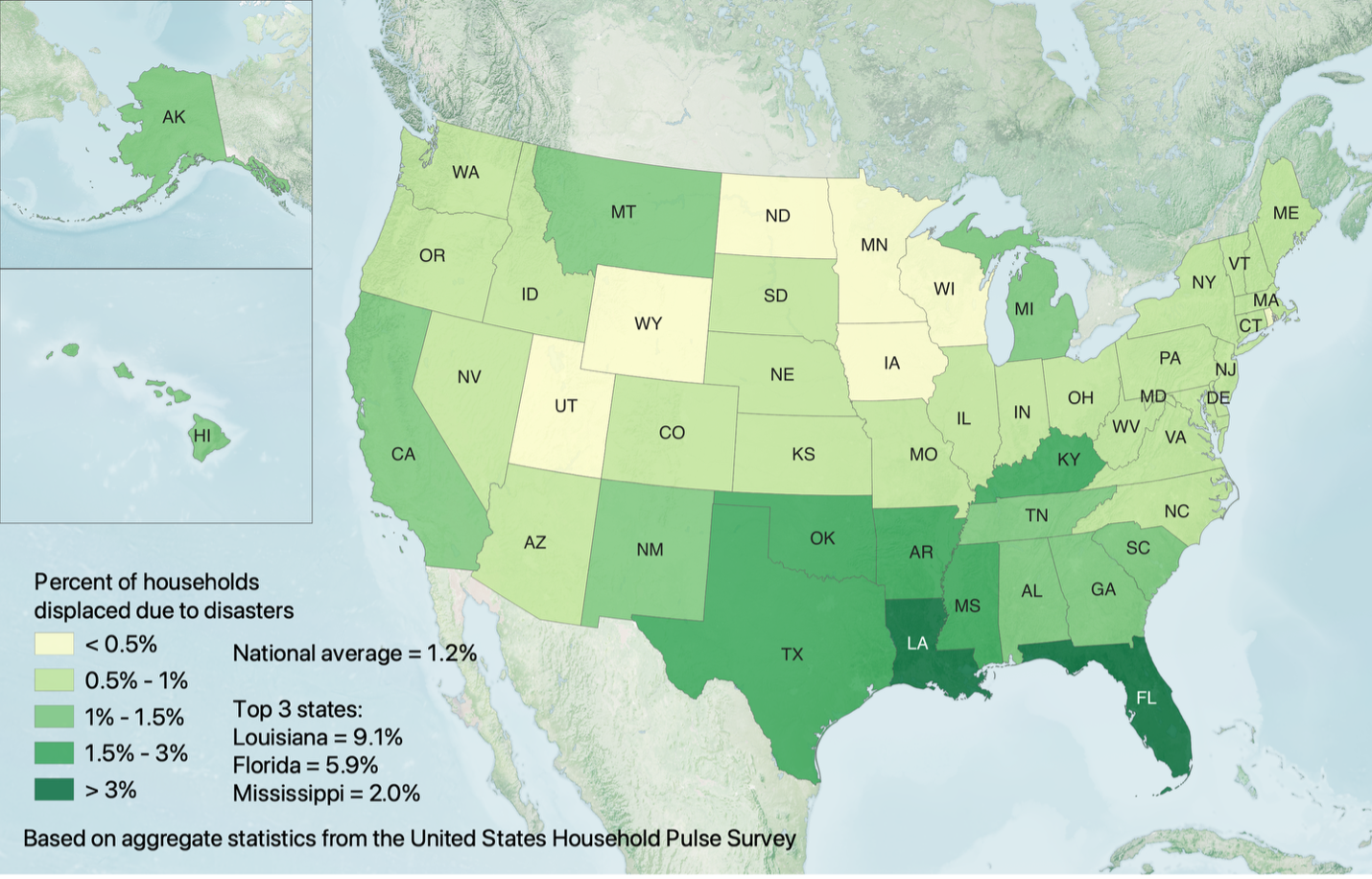
Publications:
Paul, Nicole, Carmine Galasso, Jack Baker, and Vitor Silva. 2025. “A Predictive Model for Household Displacement Duration after Disasters.” Risk Analysis. https://doi.org/10.1111/risa.17710.
Project webpages: https://hps.nicolepaul.io/
GitHub page to source code: https://github.com/nicolepaul/hps-displacement
Funding:
College London Overseas Research Scholarship (ORS)
Willis Towers Watson Research Network
SimCenter software used: quoFEM
Keywords: Floor accelerations, force-limiting connections, global sensitivity analysis, higher modes, steel spines
Researchers from a U.S.–Japan collaboration are advancing the design of low-damage, seismic-resilient buildings through the development and testing of Frame-Spine systems with force-limiting connections (FLCs). These systems are designed to reduce drifts and floor accelerations during earthquakes, thereby improving life safety and limiting nonstructural damage. Using full-scale shake-table tests at Japan’s E-Defense facility, the team investigated how modeling uncertainty—both in model form and parameter values—affects predictions of seismic response. By applying global sensitivity analysis techniques, they identified modeling features that most influence peak story drift and floor acceleration demands. Notably, the spine-to-frame connection assumptions were found to significantly impact acceleration estimates, pointing to an important design consideration for future applications of spines and FLCs. The results not only validate numerical models against large-scale experimental data but also provide clear guidance on which parameters require refinement and which can be simplified without compromising accuracy.
The NHERI SimCenter’s quoFEM application played a critical role in this research by generating parameter samples, integrating OpenSeesPy for structural simulation, and computing uncertainty quantification metrics such as Sobol indices. This streamlined workflow enabled systematic forward propagation of modeling uncertainties, producing probabilistic estimates of drifts and accelerations for direct comparison with shake-table data. Beyond advancing computational efficiency, the findings offer practical value for industry by informing design choices and potentially guiding updates to U.S. design standards like ASCE 7 and AISC Seismic Provisions. By improving the reliability of simulation-based seismic design, this work supports the broader adoption of advanced structural systems and strengthens community resilience to earthquake hazards.
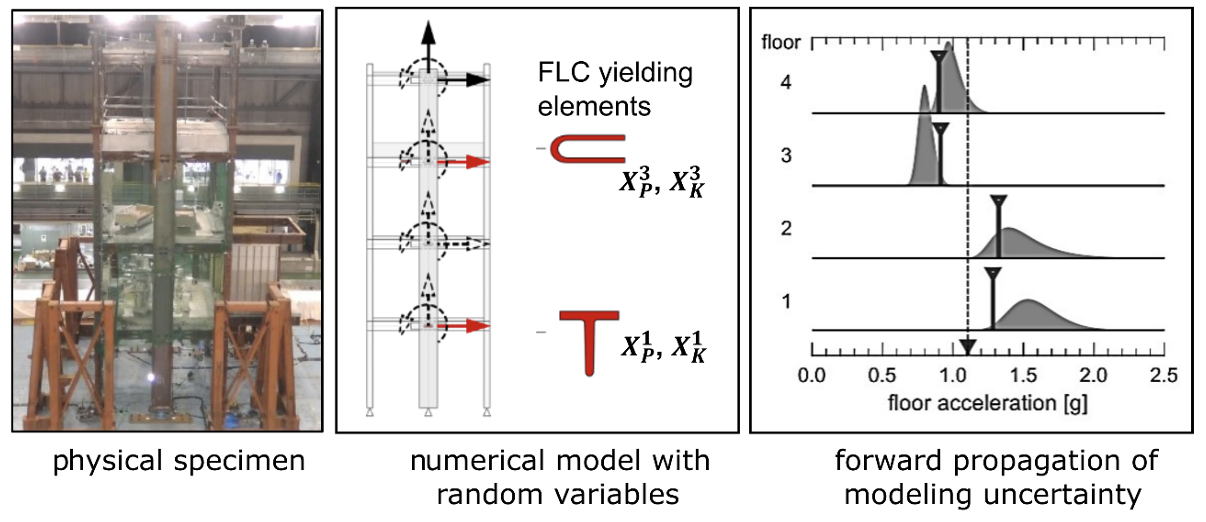
Publications:
Astudillo, B., Rivera, D., Duke, J., Simpson, B., Fahnestock, L. A., Sause, R., Ricles, J., Kurata, M., Okazaki, T., Kawamata, Y., Tao, Z., & Qie, Y. (2023). Modeling uncertainty of specimens employing spines and force‐limiting connections tested at E‐defense shake table. Earthquake Engineering & Structural Dynamics, eqe.3976. https://doi.org/10.1002/eqe.3976
Funding:
Collaborative Research: Frame-Spine System with Force-Limiting Connections for Low-Damage Seismic-Resilient Buildings (CMMI 1928906, 1926326, and 1926365)
Note: As of August 2025, this work is on-going.
SimCenter software used: R2D
Keywords: Quantitative and qualitative analyses; anti-price-gouging law; agent-based simulation; community disaster loss simulation; disaster policy
Researchers have developed a novel narrative-numeric (NN) method to assess the effectiveness of anti-price-gouging laws in the aftermath of disasters. Using a simulated post-earthquake scenario in San Francisco, the study integrates quantitative modeling with qualitative policy considerations to capture dynamic factors such as production cost changes, demand surges, infrastructure damage, donations, and hoarding. These elements interact to produce key decision metrics—including unfulfilled basic needs, repair delays, and overall well-being loss—revealing that the success of price caps is highly dependent on local conditions and community priorities. Rather than offering a one-size-fits-all recommendation, the framework enables context-sensitive evaluation, supporting more nuanced and effective disaster policy design.
The research leveraged NHERI SimCenter’s R2D tool to simulate community-level physical losses from an earthquake. The tool was used to estimate building damage and repair costs, which were subsequently used to evaluate impacts on price increase in essential goods and services and household finances and well-being. By quantitatively bridging physical damage and financial losses to social impacts, the approach facilitates interdisciplinary collaboration and evidence-based decision-making among policymakers, economists, engineers, and community stakeholders. The method demonstrates how Disaster Resilience Engineering can be integrated with economic and social context to enable systems-view, multidisciplinary management of socio-economic resilience.
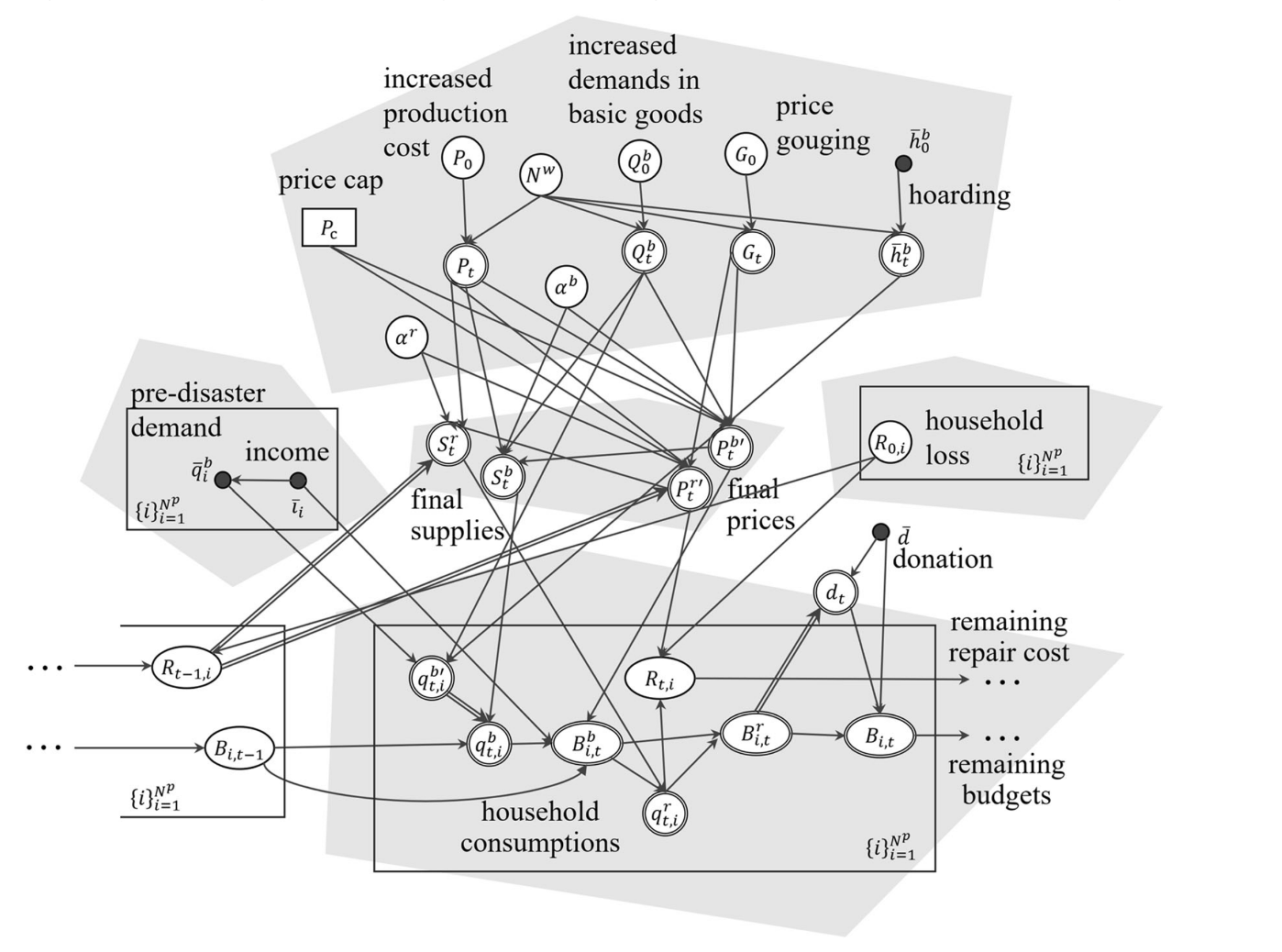
Publication:
Byun, JE., Yi, Sr. Anti-price-gouging law is neither good nor bad in itself: a proposal of narrative numeric method for transdisciplinary social discourses. npj Nat. Hazards 1, 4 (2024). https://doi.org/10.1038/s44304-024-00005-y
SimCenter software used: R2D
Keywords: Batch active learning, Gaussian process regression, Route optimization, Mutual information, Post-earthquake damage and loss assessment
This research presents an innovative active learning framework to improve the efficiency and accuracy of post-earthquake reconnaissance planning. By integrating Gaussian process regression with an information-theoretic selection criterion, the method identifies batches of high-value buildings for inspection that are most likely to improve regional damage and loss predictions. An optimized routing strategy then minimizes travel time between inspection sites, allowing reconnaissance teams to cover the most informative locations while conserving limited post-disaster resources. When applied to different earthquake testbeds—including the 2018 Anchorage, Alaska earthquake—the framework achieved up to a 53% reduction in required inspections while improving predictive accuracy compared to conventional approaches, demonstrating its potential for faster, more cost-effective post-disaster assessments.
The NHERI SimCenter’s R2D tool – particularly its backend, rWhale – played a key role in this work by generating testbed data and enabling evaluations with both real-world earthquake records and physics-based simulated ground motions. The approach offers significant societal benefits by accelerating post-earthquake damage assessment, improving agency decision-making, and informing equitable allocation of emergency resources such as shelters. By reducing the time, travel, and costs associated with data collection while preserving or improving accuracy, this framework supports rapid, informed recovery planning and strengthens community resilience in the aftermath of earthquakes.
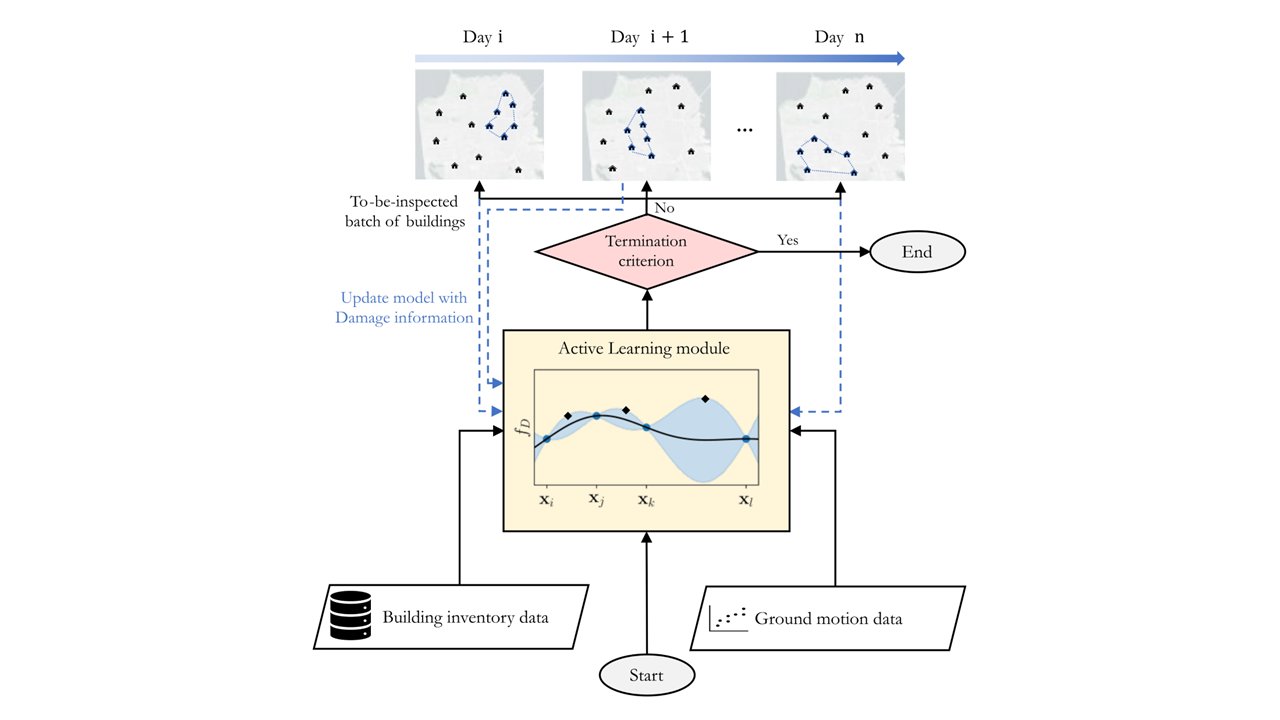
Publications:
Cheraghi, A., Wang, Y., Markovic, N., Ou, G. (2024) Efficient post-earthquake reconnaissance planning using adaptive batch-mode active learning. Advanced Engineering Informatics. 60 102414. https://doi.org/10.1016/j.aei.2024.102414
Wang, Y., Cheraghi, A., Ou, G., & Marković, N. (2024). Post-earthquake building damage assessment: A multi-period inspection routing approach for Gaussian process regression. Transportation research part E: logistics and transportation review, 186, 103548. https://doi.org/10.1016/j.tre.2024.103548
Funding: The work is supported by the National Science Foundation, under award number 2112758.
Note: As of August 2025, this work is on-going.
SimCenter software used: R2D
Keywords: Transportation resilience; Simulation-free model; Bridge ranking approach; Earthquake-related scenarios; Random forest
Researchers addressed the challenge of prioritizing and focussing retrofit efforts on critical bridges to maintain transportation network resilience after seismic events. Conventional approaches rely on computationally expensive traffic simulations to assess network performance and identify critical infrastructure. To accelerate this process, researchers developed a “simulation-free” surrogate model combining Markov random walk and random forest methods, along with a novel bridge ranking framework integrating One-at-a-time, Sobol index, and Gini importance measures. Applied to the San Francisco Bay Area highway network, the surrogate model achieved a 98% reduction in computation time—approximately 400 times faster than traditional agent-based traffic flow models—while maintaining high predictive accuracy (R² = 0.95, MAPE = 1.62%). This efficiency significantly reduces the need for extensive training datasets, enabling more rapid assessment of network vulnerabilities across numerous earthquake scenarios.
Leveraging NHERI SimCenter’s R2D tool to generate seismic scenarios in the Bay Area region, the research team successfully demonstrated their model’s ability to identify critical bridges whose retrofit would most improve network performance after earthquake events. By streamlining the process of seismic risk evaluation for large-scale transportation systems, the study provides decision-makers with a fast and practical method for prioritizing infrastructure investments. Beyond technical advancements, the approach offers tangible societal benefits: enabling more effective use of limited resources, improving community resilience through targeted retrofitting, and supporting faster recovery of mobility in earthquake-prone regions.
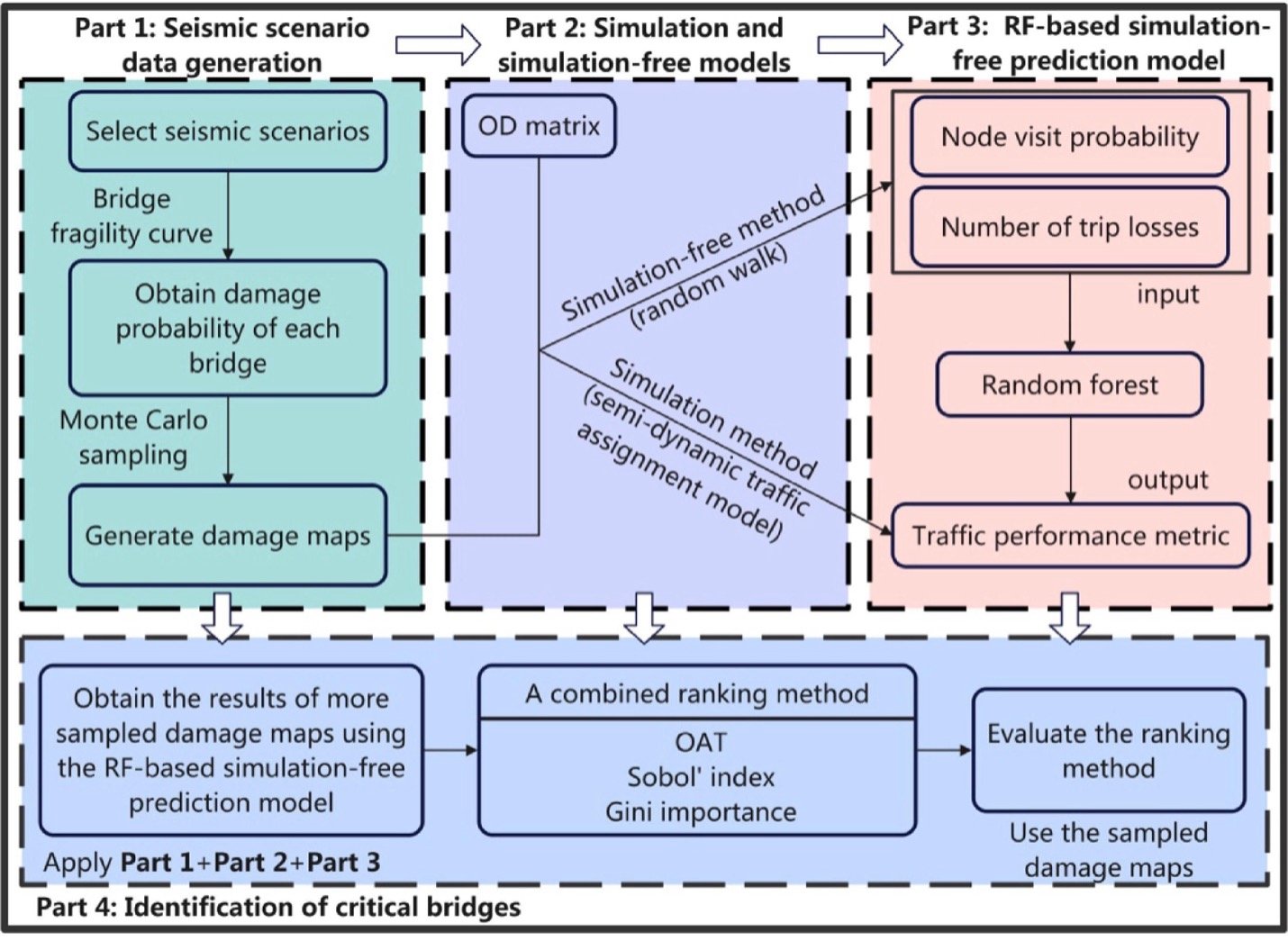
Publication:
Pengshun Li, Ziqi Wang, Bingyu Zhao, Tracy Becker, Kenichi Soga,
Surrogate modeling for identifying critical bridges in traffic networks under earthquake conditions, Transportation Research Part D: Transport and Environment, Volume 138, 2025, 104512, ISSN 1361-9209, https://doi.org/10.1016/j.trd.2024.104512
Project website:https://peer.berkeley.edu/news/peer-proposed-research-summary-prioritizing-regional-needs-recovery-bridges-through-post
Funding: The California Department of Transportation (Caltrans) supported this work through the Transportation System Research Program of the Pacific Earthquake Engineering Research Center (PEER).
SimCenter software used: Pelicun
Keywords: Self-centering frames; Buckling-restrained braced frames; Functional recovery; FEMA P-58; Resilience
Researchers at the University of British Columbia evaluated the post-earthquake functional recovery of an innovative seismic system—hybrid Self-Centering Piston-Based Braced Frames (SC-PBBFs)—in comparison to conventional Buckling-Restrained Braced Frames (BRBFs). Using detailed nonlinear OpenSees models for low-, mid-, and high-rise prototypes, the team simulated 44 far-field earthquake scenarios and assessed performance through FEMA P-58 and ATC-138 frameworks. The study quantified recovery times, repair costs, and safety outcomes, revealing that SC-PBBFs, which combine shape memory alloy bars with friction springs, significantly reduce collapse losses and downtime due to their self-centering capability, while BRBFs tend to offer lower repair costs for acceleration-sensitive nonstructural components. These results provide actionable insights into the trade-offs between downtime, cost, and resilience—critical for advancing performance-based seismic design with recovery-focused objectives.
SimCenter’s open-source pelicun tool was used to conduct FEMA P-58-based loss assessments and to manage multi-model hazard simulations. This facilitated efficient probabilistic evaluation of functional recovery metrics across the building archetypes. The research team will share their OpenSees models, ground motion sets, and performance data upon request, broadening the applicability of their comparative recovery-based framework to other seismic systems. Beyond academic contributions, the work offers practical benefits by highlighting the potential of innovative seismic technologies, providing data that may assist municipal recovery planning, and pointing toward possible future updates to building code provisions focused on recovery. The findings have also been incorporated into graduate-level course curriculum, helping prepare the next generation of resilience-focused engineers.
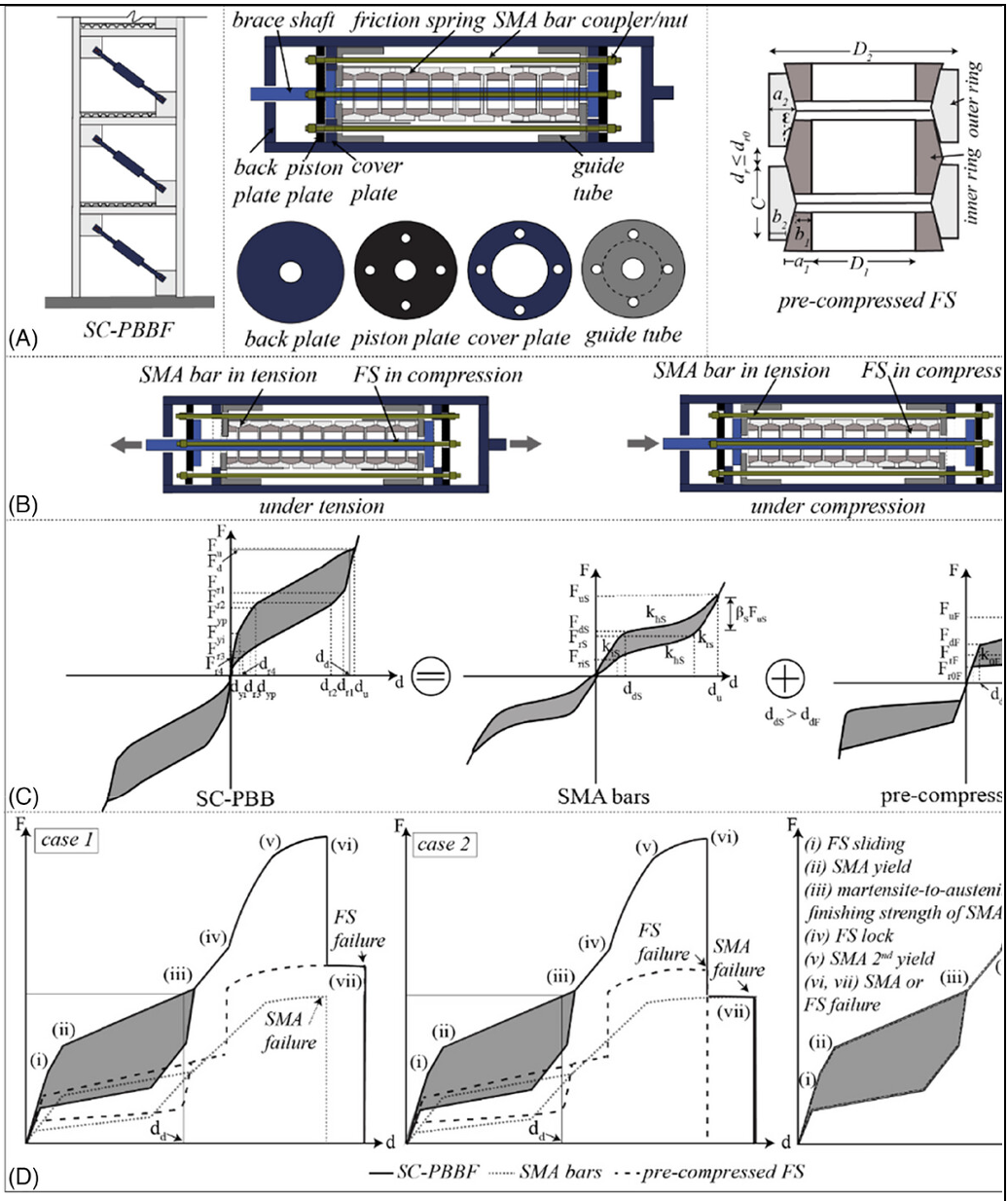 Figure 1. (A) Details, (B) mechanics, (C) cyclic response, and (D) potential failure scenarios of an SC-PBBF. (https://doi.org/10.1002/eqe.4042)
Figure 1. (A) Details, (B) mechanics, (C) cyclic response, and (D) potential failure scenarios of an SC-PBBF. (https://doi.org/10.1002/eqe.4042)
Publication:
Rahgozar N, Alam MS. Functional recovery evaluation of hybrid self-centering piston-based braced frames. Earthquake Engng Struct Dyn. 2024; 53: 867–893. https://doi.org/10.1002/eqe.4042
SimCenter software used: quoFEM
Keywords: Engineered cementitious composites, seismic retrofitting, unreinforced masonry
Researchers are developing lightweight engineered cementitious composites (ECC) for multifunctional seismic retrofitting of unreinforced masonry (URM) structures, using locally available industry byproducts in Kazakhstan. These advanced composites are designed to deliver high tensile strain-hardening capacity while remaining lightweight, with low thermal conductivity and high sound absorption. The combination of these properties enables the retrofitting system to not only improve a URM building’s seismic performance but also enhance thermal and acoustic insulation—addressing safety, comfort, and energy efficiency in a single solution. This approach aims to improve earthquake resilience, reduce energy consumption, and support sustainable structures.
The research team employed NHERI SimCenter’s quoFEM application to deterministically calibrate micromechanical modeling parameters for the ECC, incorporating hybrid fibers and industry byproducts. The team also created an improved simplified micromodel to evaluate URM walls with and without the proposed retrofit under cyclic loading. The resulting method advances seismic retrofitting strategies that are both technologically innovative and environmentally responsible, reducing carbon footprint through the use of waste materials while delivering improved resilience for a vulnerable building stock.
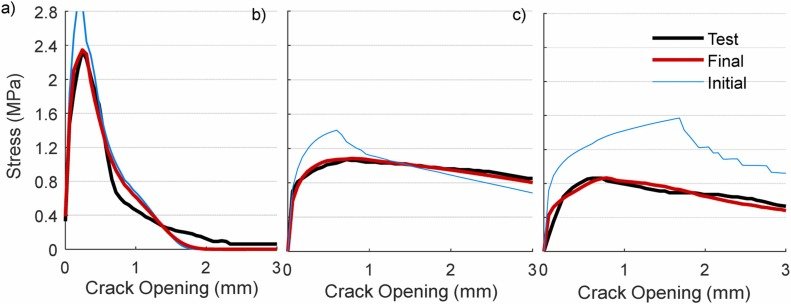
Publications:
Artyk Z., Kuan Y., Zhang D.*, Shon C.-S., Ogwumeh C.M., Kim J. Development of engineered geopolymer composites containing low-activity fly ashes and ground granulated blast furnace slags with hybrid fibers. (2024) Construction and Building Materials, 422, art. no. 135760. https://doi.org/10.1016/j.conbuildmat.2024.135760
Ogwumeh C.M., Zhang D.*, Shon C.-S., Lee D., Kim J. Experimental study on seismic performance of unreinforced masonry walls retrofitted with low-strength engineered cementitious composites. (2025) Bulletin of Earthquake Engineering, 23 (6), pp. 2647 – 2668. https://doi.org/10.1007/s10518-025-02138-5
Funding: Nazarbayev University Faculty Development Competitive Research Grants Program Grant No. 021220FD2151. Ministry of Education and Science of Kazakhstan Grant AP26194009
Note: as of August 2025, this work is on-going.
SimCenter software used: R2D and pelicun
Keywords: Regional assessment, high-fidelity, high-resolution, seismic risk, resilience
Researchers are advancing the next generation of seismic risk and resilience assessment through the development of a high-fidelity, high-resolution computational framework capable of analyzing thousands of buildings at the regional scale. Traditional building codes have emphasized life safety, but national initiatives now call for codifying functional recovery as a performance objective—bringing economic loss, downtime, and long-term recovery into focus. This project presents an efficient framework that integrates automation, optimization, and distributed computing to make previously infeasible large-scale risk and resilience evaluations computationally viable. A case study on more than 15,000 residential woodframe buildings in Los Angeles demonstrates how such assessments, once requiring months of computation, can now be completed within days.
The research leveraged NHERI SimCenter tools, including R2D for regional hazard simulation and pelicun for loss estimation, as core components of its workflow. These tools, along with Auto-WoodSDA (which builds on Pelicun), enabled the seamless integration of hazard modeling, probabilistic simulation, and building-specific performance assessments with site-specific ground motion inputs. By validating and advancing computational strategies for regional seismic analysis, the study not only pushes the boundaries of high-resolution resilience assessment but also lays the groundwork for practical policy and planning applications. The resulting framework offers decision-makers the ability to evaluate resilience-based standards, identify vulnerable neighborhoods, and inform mitigation strategies that strengthen community resilience to future earthquakes.
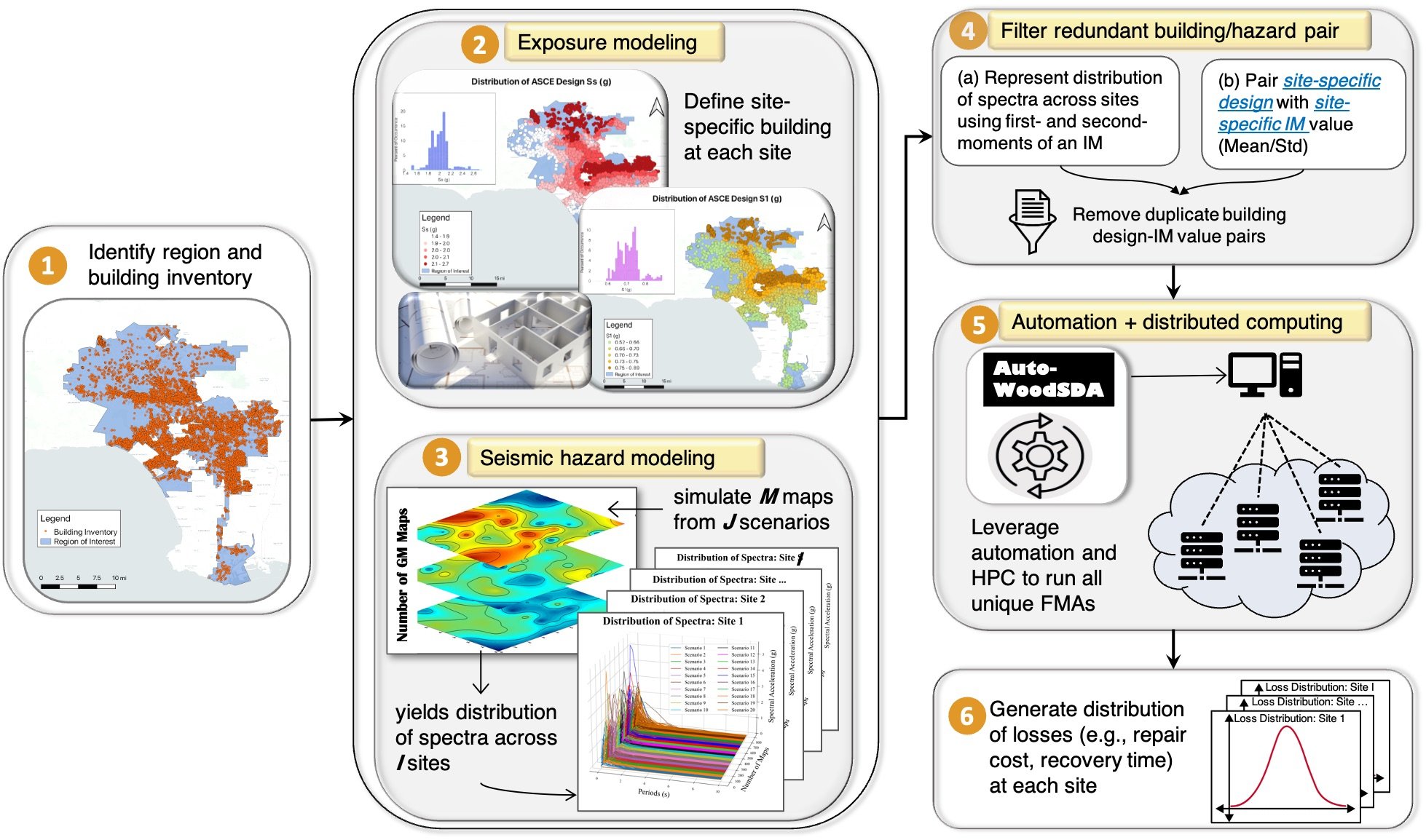
Publication:
Dahal, L., Burton, H., Zhong, K. (2025) High-Fidelity High-Resolution Regional Seismic Risk and Resilience Assessment of Large Building Inventories. Earthquake Engineering and Structural Dynamics. https://doi.org/10.1002/eqe.4313